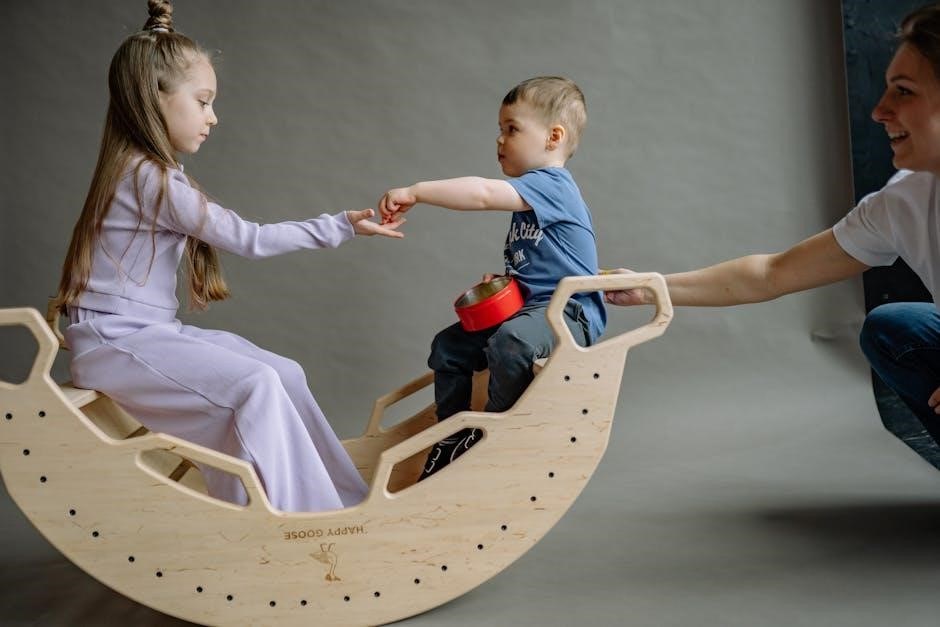GDScript 2․0 is a Pythonic, high-level scripting language designed for Godot 4, offering an accessible and intuitive way to create games․ It streamlines development with dynamic typing and built-in engine integration․
1․1 Overview of GDScript 2․0
GDScript 2․0 is a modern, Python-inspired scripting language tailored for the Godot 4 engine․ It introduces enhanced syntax features, improved error handling, and better performance․ Designed for accessibility, it supports dynamic typing and seamless integration with Godot’s node-based architecture․ The language is ideal for both 2D and 3D game development, offering built-in functions for common tasks․ Its simplicity makes it beginner-friendly, while advanced features cater to experienced developers․ GDScript 2․0 streamlines game creation, fostering creativity and efficiency in the development process․
1․2 Why Choose Godot 4 for Game Development
Godot 4 is a powerful, open-source game engine that offers a versatile platform for both 2D and 3D game development․ Its community-driven nature ensures constant updates and improvements, while its free and open-source model makes it accessible to developers of all levels․ With enhanced rendering capabilities through Vulkan, Godot 4 delivers superior performance and visual quality․ The engine’s cross-platform support and extensive built-in tools streamline development, making it an ideal choice for creating high-quality games efficiently․ Its flexibility and user-friendly interface cater to both indie developers and larger teams․

Installation and Setup of Godot 4
Download Godot 4 from the official website and follow the straightforward installation process․ The engine includes a built-in editor, making it easy to start developing with GDScript․
2․1 Downloading and Installing Godot 4
Download Godot 4 from the official website (godot․org)․ Choose the appropriate version for your operating system (Windows, macOS, or Linux)․ The download is free and open-source․ Once downloaded, follow the installation instructions for your platform․ The process is straightforward and quick․ After installation, launch Godot to access the built-in editor and start creating projects with GDScript․ Ensure your system meets the minimum requirements for smooth performance․ No additional tools are needed, making it ideal for beginners and experienced developers alike․
2․2 Setting Up the Development Environment for GDScript
After installing Godot 4, launch the engine to set up your development environment․ Create a new project and select the desired game type (2D or 3D)․ Familiarize yourself with the Godot editor, including the scene tree, nodes, and script tabs․ GDScript files can be created directly within the editor․ Organize your project by structuring scenes and scripts in a logical directory․ Ensure the GDScript language is selected in the project settings for proper syntax highlighting and auto-completion․ Use the built-in template system to start projects quickly and efficiently․
Getting Started with GDScript
GDScript 2․0 is a high-level, dynamic language for Godot 4, offering an accessible way to create game logic․ Start by creating and attaching scripts to nodes, leveraging built-in functions and signals․ Use the script editor to write and debug code, ensuring proper syntax and structure․ Begin with simple scripts to understand execution flow and node communication, laying a solid foundation for more complex projects․
3․1 Basic Syntax and Features of GDScript
GDScript 2․0 features a clean, Python-like syntax with dynamic typing and indentation-based code blocks․ Variables are declared using var or let, and functions are defined with func․ Built-in functions like print simplify debugging․ Signals enable node communication, while extends allows script inheritance․ The language supports arrays, dictionaries, and enums, with built-in math and string operations․ GDScript’s syntax is designed for readability, making it easy to write and debug code within the Godot editor․
Dynamic typing reduces boilerplate, and first-class functions enable flexible scripting․ The language integrates seamlessly with Godot’s node system, providing an efficient workflow for game development․
3․2 Data Types, Variables, and Operators in GDScript
GDScript supports various data types, including integers, floats, strings, booleans, and specialized types like Vector2, Rect2, and Color․ Variables are declared using var or let, with onready for node references․ Operators include arithmetic (+, -), comparison (==, !=), logical (and, or), and assignment operators․ The as keyword enables type casting, while enums and null values simplify data handling․ GDScript’s dynamic typing makes variable management flexible and intuitive for developers․
String interpolation and built-in functions like str and int enhance data manipulation․ These features make GDScript accessible for beginners while maintaining robust functionality for complex game development tasks․
Node-Based Architecture in Godot 4
Godot 4 uses a node-based architecture, where scenes and nodes form a hierarchical structure․ Nodes can be extended with GDScript, enabling modular and reusable game components․

4․1 Understanding Scenes, Nodes, and the Node Tree

In Godot 4, scenes represent individual game levels or screens, while nodes are the building blocks within these scenes․ The node tree, visible in the Scene tab, organizes nodes hierarchically․ Each node can be a sprite, script, or other game object․ Nodes communicate through signals and callbacks, enabling interaction․ This structure simplifies game logic and enhances scalability․ Understanding scenes, nodes, and their relationships is crucial for effective game development in Godot 4, allowing developers to manage complexity and create modular, reusable components efficiently․
4․2 Extending Nodes with GDScript
Nodes in Godot 4 can be extended using GDScript to add custom behaviors and functionality․ By attaching scripts to nodes, developers can define how they interact with the game world․ Scripts can handle signals, such as user input or collisions, and modify node properties dynamically․ Inheritance allows scripts to extend base node classes, creating reusable components․ This approach enables developers to build complex game mechanics while keeping code organized and maintainable, leveraging GDScript’s simplicity and integration with Godot’s node system for efficient game development workflows․

Scripting Game Logic
GDScript enables developers to create dynamic game mechanics by handling events, implementing functions, and controlling flow․ It simplifies scripting, making it easy to add interactivity and logic to games․
5․1 Functions, Control Flow, and Event Handling
GDScript 2․0 simplifies game logic with functions, enabling modular and reusable code․ Control flow statements like if/else and for loops allow conditional execution and iteration․ Event handling is core to interactivity, with signals connecting node behaviors․ Developers can define custom functions to encapsulate logic, improving readability․ Built-in engine events, such as _process and _input, enable real-time responses to user actions and game state changes․ This structure makes it easy to implement complex mechanics while keeping code organized and maintainable․
5․2 Implementing Player Input and Movement
GDScript 2․0 makes player input and movement straightforward with its intuitive API․ Use the Input class to detect keyboard, mouse, and gamepad events․ Implement movement by applying forces or velocities using Vector2․ The engine’s input actions system allows custom mappings for flexibility․ Smooth movement is achieved with delta-based updates, ensuring frame-rate independence․ Built-in functions like move_and_slide simplify physics-based motion․ This approach enables developers to create responsive and engaging player controls efficiently, leveraging Godot 4’s enhanced input handling capabilities․
Creating a Simple 2D Game
Design a simple 2D game using GDScript 2․0․ Create a coin collection game with sprites, collision detection, and UI elements for scoring․ Learn foundational game development concepts and implement core mechanics with Godot 4’s built-in tools and features․
6․1 Designing a Coin Collection Game
Begin by setting up a 2D game scene with a player character and collectible coins․ Use sprites for the player and coins, and implement collision detection to trigger collection events․ Create a simple UI to display the score and instructions․ Learn to animate the player and coins, and add basic movement controls․ Use GDScript 2․0 to write logic for coin collection, scoring, and win/lose conditions․ This project introduces core game mechanics, asset management, and event handling in Godot 4․
6․2 Adding UI Elements and Scoring System
Add UI elements like labels and buttons to display the score and game status․ Use Godot’s built-in UI nodes to create a user-friendly interface․ Implement a scoring system by tracking collected coins and updating the score in real-time․ Write GDScript logic to increment the score when a coin is collected and reset it when the game restarts․ Ensure the UI elements are properly anchored and visible during gameplay․ This step enhances player feedback and engagement, making the game more interactive and enjoyable․

Best Practices and Next Steps

Organize code using GDScript’s built-in features and explore resources for further learning․ Expand projects by leveraging Godot 4’s advanced capabilities and community-driven documentation for continuous improvement․
7․1 Organizing Code and Using Built-In Features
Organize your GDScript code by utilizing built-in features like scenes, nodes, and signals․ Structure your project logically, separating game mechanics, UI, and logic; Use Godot’s node system to manage dependencies and ensure clean, modular code․ Leverage the engine’s built-in functions and classes to streamline development, reducing redundancy and improving maintainability․ This approach enhances readability and makes your codebase easier to scale as your project grows․
7․2 Resources for Further Learning and Project Expansion
Expand your knowledge with the Godot 4 Game Development Cookbook, offering 50+ recipes for high-quality 2D and 3D games․ Explore the Godot 4 Game Development Projects book for hands-on experience․ Visit the official Godot documentation for comprehensive guides․ Join the Godot community forums for support and inspiration․ Check out tutorials on creating a simple coin collection game and leveraging GDScript 2․0 features․ Utilize the Godot Asset Library for pre-built assets and plugins to enhance your projects․
